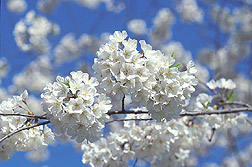This page has been archived and is being provided for reference purposes only. The page is no longer being updated, and therefore, links on the page may be invalid.
|
|
100th Anniversary of Washington's Cherry Blossoms CelebratedBy Alfredo FloresApril 2, 2004 WASHINGTON, April 2, 2004--The U.S. Department of Agriculture today promoted the newest variety of its flowering cherry trees, First Lady, during a tree-planting ceremony at the U.S. National Arboretum. The ceremony marked the 100th anniversary of the department's first introduction of flowering cherry trees to the United States. "It is appropriate to celebrate this new cherry tree variety during the National Cherry Blossom Festival," Agriculture Secretary Ann M. Veneman said. "USDA's Agricultural Research Service conducted the research to develop this new series that promises many future varieties for the public to enjoy." The arboretum, operated by the Agricultural Research Service, is home to 76 varieties of flowering cherry trees and to the research that maintains them. The arboretum's latest flowering cherry, First Lady, was released late last year by ARS plant geneticist Margaret R. Pooler. First Lady is a 25-foot-tall, upright tree with dark-pink, single, semi-pendulous flowers. It is part of a series of new flowering cherry trees that will be released in the future, and named in honor of different First Ladies. Several grow at a site near the historic Capitol Columns that were once part of the U.S. Capitol and are now installed on the arboretum grounds. Arboretum researchers have also released a flowering cherry called Dreamcatcher, a 25-foot, v-shaped tree with medium-pink flowers and dark-green foliage. The National Cherry Blossom Festival held in Washington each March celebrates the gift of 3,000 Yoshino cherry trees given to President Taft in 1912 as a gift from the people of Japan. In return, the U.S. government gave the people of Japan a gift of flowering American dogwood trees in 1915. Researchers at the arboretum have cloned many of the original cherry trees, to maintain the plantings around the capital's Tidal Basin that draw thousands of visitors from around the world each spring. For nearly half a century, they have worked on improving varieties of flowering cherries for ornamental use. In fact, some of the original Yoshino cherries have been used to develop new plants that are currently under evaluation. The National Cherry Blossom Festival also marks the anniversary of the signing of the Treaty of Peace and Amity between the United States and Japan, in 1854. This year is the 150th anniversary of that treaty, which officially began formal relations between the two countries. For the festival, honorary Japanese "princesses" are chosen to represent the gift of dogwood trees, and American "princesses" represent the flowering cherry gift. Three of this year's cherry blossom and three dogwood princesses attended today's tree-planting ceremony. Today's ceremony was also attended by a delegation from the Japan Cherry Blossoms Association, along with representatives from the Embassy of Japan and a 20-member delegation from the Ozaki Memorial Center in Ishe, Japan. Yukio Ozaki, mayor of Tokyo from 1903 to 1912, arranged to send the original trees to the United States. Located in northeast Washington, the U.S. National Arboretum maintains the area's most diverse array of flowering cherry trees and is open to the public seven days a week. |

